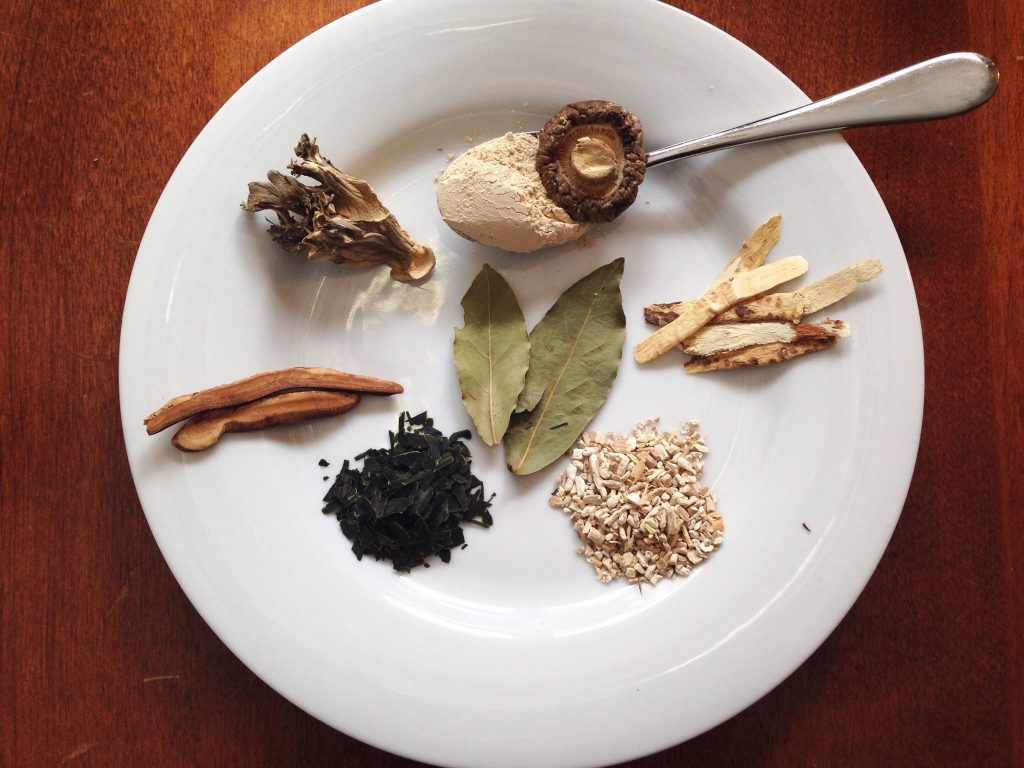What’s the Big Deal About Broth?
Throughout history and our modern world, many cultures thrive on broth (and closely related “stock”) as a mainstay of a healthy diet. Simmering bones, meat, and veggie scraps for hours infuses the water with flavor, vitamins, minerals, and other useful compounds in a highly bioavailable. Broth, stock, and simple soups are enjoyed in more elaborate dishes or sipped with breakfast or before an entree to warm the body, nourish the soul, and curb overeating, particularly in Asian and Indian cuisine.
I appreciate this simple, economical, and nutrient-dense food in the context of the frugal deliciousness of my own family food heritage: my Sicilian mother’s cross-stitched “Waste Not, Want Not” plaque hung above our dinner table; my Nova Scotian grandmother’s back-to-the earth organic homestead where even bacon grease found new life (as soap!); Korean and Chinese relatives who employ chicken feet, fish heads, hot pot soups, and Thanksgiving turkey bones for flavor-packed dishes that stretch out scraps most Americans toss in the trash.
Many different types of broth are enjoyed – vegetable, miso, animal-based – but perhaps the trendiest broth is “bone broth,” which is made by simmering chicken, beef, fish, or other animal bones for many hours over low heat, sometimes with a splash of vinegar. The best bone broths jiggle with gelatin and collagen when they cool, a source of great pride in home chefs (though jiggle-free broth is still loaded with good stuff!). Bone broth popularity has skyrocketed in recent years with Nourishing Traditions/Western A. Price Foundation and Paleo food trends. With long simmering, connective tissue from the scraps dissolves into the broth, potentially making it more beneficial for our own connective tissue vitality: joints, skin, etc. Proponents believe that broth is not only delicious but may ease chronic pain, health the gut, and gradually alleviate autoimmune disease. The longer simmering time, bones, joints, and bits of meat may also extract more minerals like calcium, and approximately 10 times more protein content than more basic broths (study available here). More menus and grocery stores feature bone broth, and specialty broth restaurants have popped up in hipster neighborhoods.
Unfortunately, your typical store-bought “broth” is devoid of this goodness and little more than a delivery system for insanely high sodium levels and MSG or glutamate-related compounds, even the natural and organic ones. Meanwhile, purchasing the “good stuff” costs a small fortune – up to $10 per serving for bone broth – but any good home cook knows you can make a vat of broth with ease on leftovers for a fraction of the price.
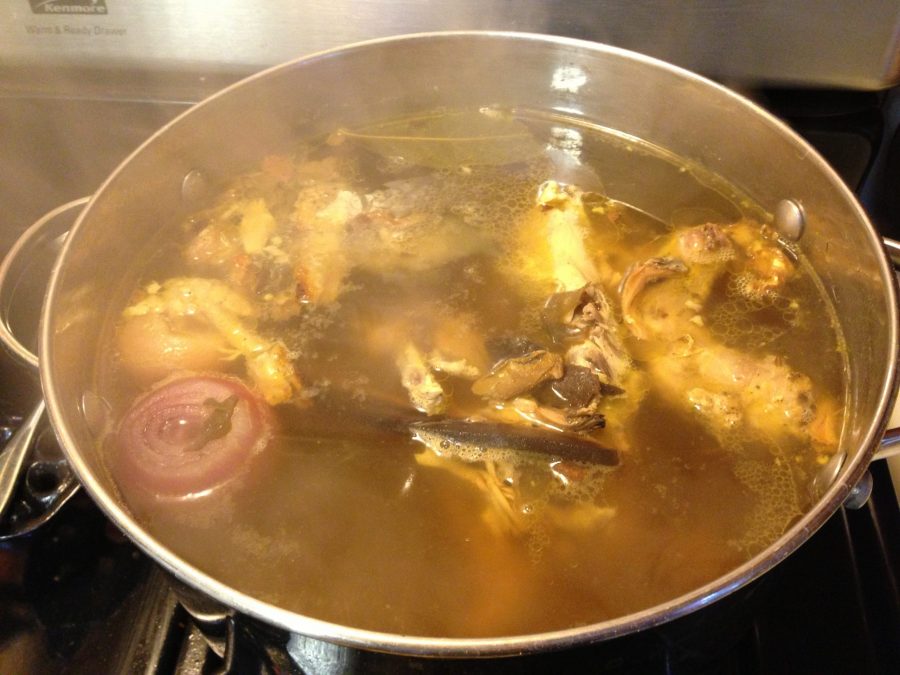
Basic Chicken Bone Broth Recipe
Here’s a basic recipe to start you off. Chicken is an easy go-to starter broth because it’s possibly the most delicious broth and easily accessible as an ingredient. To save money at the store, we often buy whole chickens, butcher it into smaller pieces to make multiple meals, then save the main carcass in the freezer for broth. You can also roast a whole chicken, eat the meat, then throw all your leftover bones into the pot.
Feel free to sub in other animal scraps like fish bones/heads or oven-roasted beef bones, cross-cut marrow bones. Chicken wings or feet, beef knuckles, shanks, and pig hooves have the most gelatin and other giggly-worthy compounds. Cooked or raw, carcasses and other leftover dinner bones freeze well until you have time to make broth. Leftover ham bone? Leg of lamb? Turkey carcass from Thanksgiving? Shrimp shells? Save it to make broth!
Vinegar is optional and imparts a sour flavor (easy does it!) but may help extract more minerals from the bones. Certainly, feel free to add vegetables such as carrots, celery, parsley, and onion to the simmering pot for sweetness and more complex nutrition and flavor.
- 1 whole chicken or 2 chicken carcasses
- 1 gallon of water, or enough to cover bones
- Salt to taste
- Splash of apple cider vinegar, optional
Simmer, covered, for a minimum of 3 hours or preferably all day. If you were using a whole chicken, remove carefully, let cool, and pull away the meet to save for other recipes. Strain. Remove fat if desired (this is easier to do after it cools). Season to taste. Freeze or refrigerate to enjoy plain or as a base ingredient in soup, stew, and sauces.
Love Gadgets? Set your Instant Pot to pressure cook for 1 to 2 hours. Or use your slow cooker for 12 to 24 hours on low.
Straining: You can strain it out via all sorts of kitchen tools (cloth-lined colander, hand strainer…). I like to use medium stainless-steel fine metal cone strainer that fits mason jar funnel. Then I simply ladle into my mason jars, let cool a bit on the counter, transfer to the fridge. I personally put it into half-gallon mason jars first to let it cool overnight in the fridge, then skim off the fat before pouring into my smaller freezer-safe jars.
Freeze It: Stock your freezer so you have easy access to broth for long periods of time! I prefer to freeze mine in individual 16-ounce wide-mouth mason jars that I can thaw in the fridge or microwave as needed. If you use mason jars, make sure the ones you use are freezer-safe (check the label – they’re generally the straight-sided ones that don’t curve at the top) and abide by the recommended fill line. Plastic deli containers also work fabulously (but they are, well, plastic). Simply run the container under warm water, and the big broth “cube” pops out into your pan to warm quickly on the stove.
Concentrate It: This takes up less space and – though it requires extra steps up front – can be more convenient for use. Simmer the strained broth uncovered until it has reduced to ¼ its original volume. Let cool, then freeze in ice cube trays. Put the cubes in a re-sealable bag once frozen, then simply thaw one or two cups per mug of hot water or toss into recipes.
Use It: Sip it straight or use it to make soups and stews of all kinds. If you find that you’re not in love with the flavor, pair it with plain broth or water in strongly-flavored recipes like chili and jambalaya.
Vegetarian?
Veggie broths also offer fantastic nutrition. They don’t contain the connective tissue compounds you get in bone broth, but they’re also done in much less time, 30 minutes to a few hours versus all day. Instead of bones, use vegetables or scraps such as onions, garlic, parsley, carrots, celery, corn cobs, winter squash (or just the seeds and skins), etc. Adding the herb horsetail to your simmering broth will amp up the silica and offer joint- and connective-tissue support. If you’d like, stir in a spoonful of miso just before serving for broth-y, umami flavor and probiotics.
Up Your Broth Game with Herbs & Mushrooms
Now that you realize how ridiculously easy basic broth is to make, you can begin to play around with healing and flavorful herbs, which is also… ridiculously easy! Start with just a spoonful or so of your new additions until you get the hang of how they taste and what flavors you like. You don’t want a whole gallon of something you can’t stand!
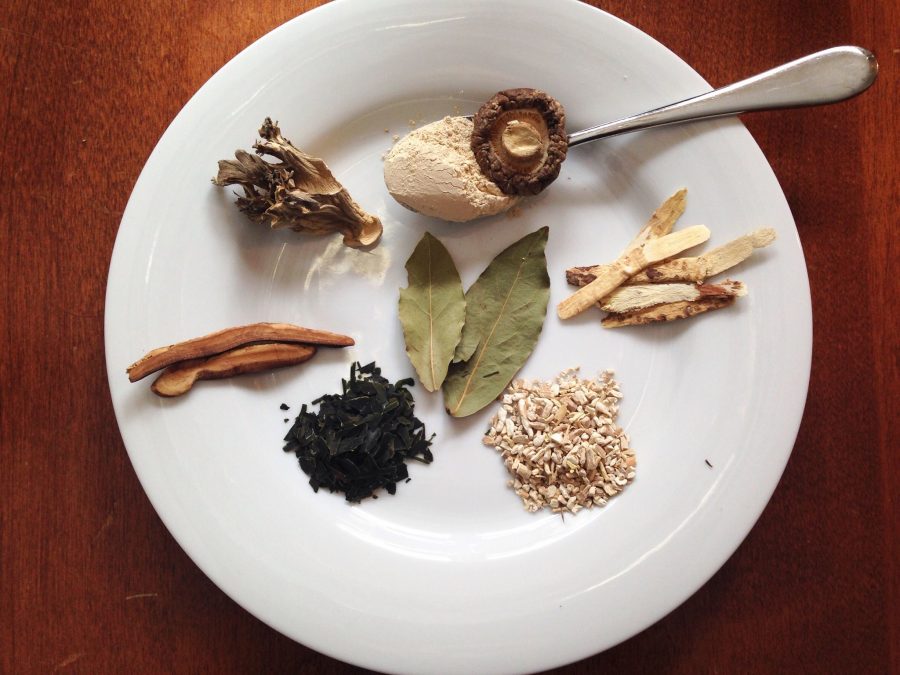
Immune Blend – From top/middle clockwise: shiitake mushroom, astragalus root, ashwagandha root, seaweed mix (optional), reishi mushroom slices, maitake mushroom, bay leaves in center.
Immune Tonics
Medicinal Mushrooms: Mushrooms add umami, mushroom-y flavor but, more importantly, the long simmering helps break down the tough fibers of the mushroom to release immune-supportive polysaccharides that help to modulate and strengthen immune function. Consider mushroom broths all winter long to improve resistance to respiratory infections, in autoimmune disease, for people with weak immune function, and for supportive cancer care. You can use fresh, frozen, dry, whole, cut, or powdered mushrooms, but powdered mushrooms likely provide the greatest concentration of polysaccharides in your finished broth. You can buy dried mushroom powder or coarsely powder up whole dried mushrooms in a bullet or coffee grinder. I use ½ to 1 cup per gallon of broth. Shiitake offers the lightest flavor and is my go-to for broth. Lion’s mane also tastes great and has nerve- and brain-healing properties. Any choice edible mushroom will do. Maitake is popular (but I prefer the flavor of fresh maitake over dried). Turkey tail mushrooms have turkey-ish flavor. And reishi is bitter but loaded with medicinal properties (due to its flavor, I usually take it in other forms).
Astragalus (Astragalus propinquus, formerly A. membranaceus): The roots of this legume also offer polysaccharides and are a nice alternative to mushrooms for people who don’t like or are allergic to mushrooms. The flavor is lightly sweet, woody, earthy, and pleasant. Start with a handful of the root slices for your first broth, but you can use much more as you get used to the flavor.
Codonopsis (Codonopsis pilosa and other species): Though unrelated botanically to ginseng, codonopsis roots are often used as “poor man’s ginseng” because it’s easier and more economical to grow but offers similar tonic, energizing, immune-supportive properties. The flavor is mostly sweet with a slight hint of bitterness. Try only a little bit at first to get a feel for the flavor and how energizing it is for you.
Additional options include ashwagandha (which is gently energizing, calming, thyroid-boosting, immune-modulating), and gotu kola (adaptogen with very mild calming-energizing properties, a brain tonic, and connective tissue, skin, and vascular support — excellent post-surgery, in gut healing, etc.).
Nutritives
Nettle (Urtica dioica): The leaves of this superfood weed surpass almost any other food for calcium, vitamin K, and other mineral content. You’ll love or hate the vegetal, mineral, spinach-y flavor. While you could safely add cups of the dried, cut-sifted herb to your soup (or fresh spring greens, be aware that it stings when fresh), start with just a spoonful or two to see how you like it first. It is a bit diuretic.
Oatstraw (Avena sativa) has milder flavor but still an impressive nutrient profile. Avoid it if you’re allergic to oats.
Horsetail (Equisetum arvensis): This common weed of damp places is the bane of gardeners because it’s so hard to get rid of. But it’s actually incredibly rich in silica, a mineral that improves the flexibility and strength of connective tissues including bones, hair, nails, skin, and joints. Studies suggest that it may also relieve pain, improve healing, reduce inflammation, and modulate immune function. Source from quality suppliers due to adulteration and contamination; this plant will bioaccumulate toxins from the soil and watershed, so harvest wisely. Simmering also helps release the tough silica into solution. Consider adding a tablespoon or two to your simmering pot. It is a bit diuretic.
Turmeric (Curcuma longa): Turmeric’s even trendier than bone broth, and for good reason! It’s loaded with anti-inflammatory, antioxidant, and other healing compounds that may help reduce pain, inflammation, heart disease, blood sugar, improve liver detoxification, prevent cancer, and more. Add a sprinkle to broth to give it a golden yellow color and up to a teaspoon or tablespoon per serving for more potent healing properties (start slow to ensure you tolerate the flavor). Beware: This dye plant stains everything yellow! Bleach removes stains quickly. Sunlight fades them eventually. Turmeric powder is readily available in any food, herb, or ethnic market, but since it is commonly adulterated with toxic ingredients, seek trustworthy and organic suppliers that do extensive quality control testing like Mountain Rose Herbs. The fresh-grated root (available in very well-stocked produce departments near ginger) can also be used.
Additional Options include seaweed (but go light — getting more than 150 mg iodine per day increases the risk of Hashimoto’s, and higher doses can cause thyroid storm/crash, plus they can be a source of heavy metals), violet leaves (tasty mild sweet-green flavor, nutritive, moistening, detox/alterative), burdock root (gentle detoxification, pleasant flavor), red clover blossoms (phytoestrogen, detox/alterative support, and nutritive), marshmallow leaf or root (slimy, mucilaginous, moistening gut healing/soothing support).
Flavor Punch
Many herbs enhance the flavor of your broth while offering healing properties. They often require less simmering time and can be added at the tail end of your broth process or to smaller batches of strained broth.
Scallions or Onions: Ever wonder why Asian broths taste soooo good? Besides the oft-added MSG, they often include a sprinkle of fresh-chopped scallions or onions shortly before serving that add instant yum-factor. Serve in broth or strain out after a few minutes for clear, texture-free broth. For a more Vietnamese-style broth, cut onions and garlic in half and char the in the pan, then simmer for 15 to 20 minutes. A whole star anise pod and cinnamon stick or two go simmered alongside. Garlic is also nice!
Lemongrass: Did you grow lemongrass in the garden this year and now you don’t know what the heck to do with it? Broth is an easy answer. Coarsely mash or chop the tightly-rolled bottom stalks (or simply leave them whole) and simmer in your broth for 20 to 30 minutes. Divine! This classic Thai and Southeast Asian ingredient blends well with simple soups featuring vegetables, beans, chicken, rice, and/or coconut milk but is also nice sipped plain. The flavor marries well with onion, scallions, ginger, hot peppers, and/or turmeric, too.
Ginger: Few Asian soups are complete without some fresh-grated ginger or charred slices that get strained out before serving. Consider ginger + onion/scallions or ginger + onion/scallions + garlic. Enhance the flavor further by adding soy sauce and toasted sesame oil. Instant flavor to enjoy on its own or use with noodles, tofu, edamame, meat, fish, and Asian-style veggies like bok choy.
Don’t feel the need to make it too complicated, though. My go-to broth is simply chicken, shiitake, salt, and water. Simmer, sip, and enjoy!
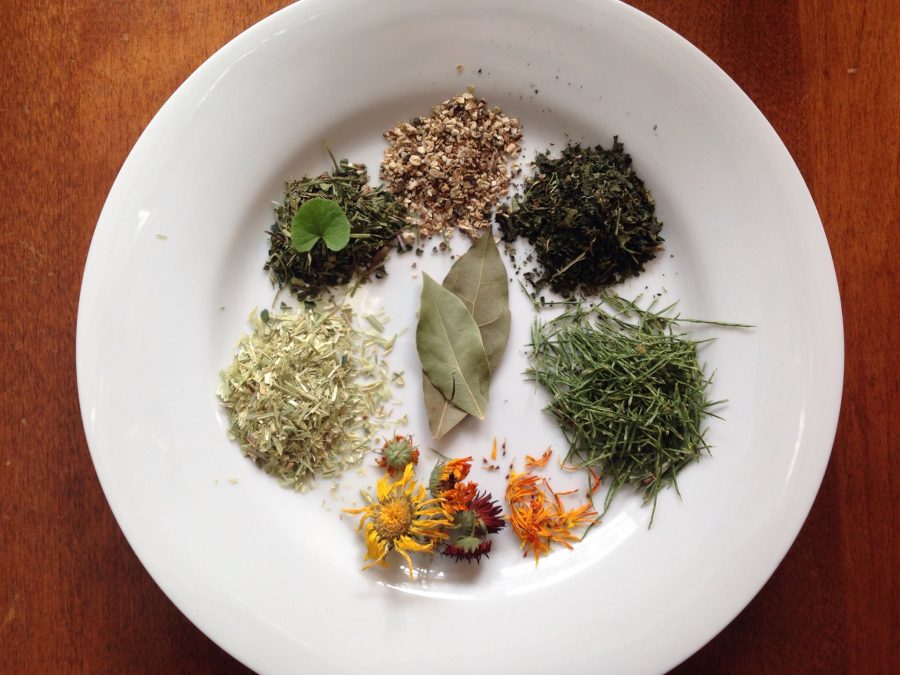
Clear & Vital Skin Blend – From top/middle clockwise: burdock root, nettle, horsetail, calendula flowers, oat straw, gotu kola, bay leaves in center.
Gut-Healing Herbs
Good candidates include gotu kola, horsetail, calendula, plantain leaf, marshmallow root, and nutritives.
Skin Support
Good candidates include gotu kola, horsetail, calendula, violet leaves, and nutritives, plus herbs that are gentle alteratives (which gently support detoxification) such as burdock roots and red clover blossoms.
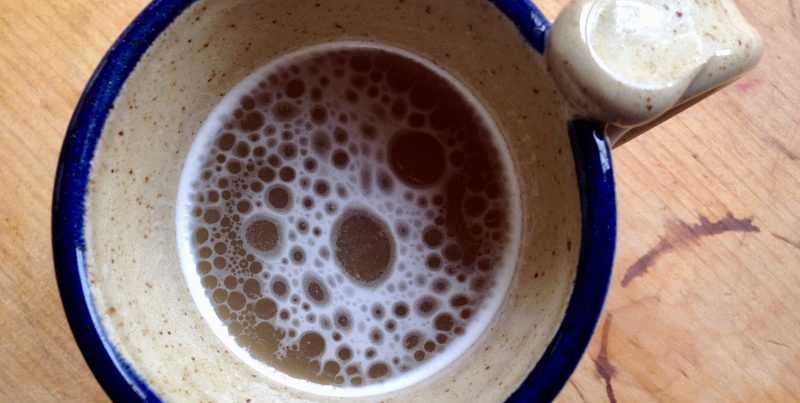
Finding Ingredients
- Soup bones and scraps can be found at meat farms and well-stocked natural food stores and farm stands. Find a farm near you via the pasture-raised farm directory eatwild.com. Always call ahead to confirm availability. You can also buy bone-in meat at the grocery store and use that. Quality matters!
- Lemongrass and other exotic fresh herbs can be grown easily in the garden or purchased from a well-stocked Asian market. Free fresh lemongrass stalks in a Ziplock bag for year-round use.
- Dried Mushrooms are available at MountainRoseHerbs.com, MushroomHarvest.com, local mushroom farms, and some specialty food suppliers. Fresh and frozen shiitake is readily available in most grocery stores.
- Dried Medicinal Herbs (if you don’t already grow and dry your own) are sold at bulk herb suppliers including herb shops, herb farms, well-stocked natural food stores, and online at com.
Clinical herbalist Maria Noël Groves sees clients and teaches classes at Wintergreen Botanicals Herbal Clinic & Education Center in Allenstown, New Hampshire.
The statements made on this blog have not been evaluated by the FDA and are not intended to diagnose, prescribe, recommend, or offer medical advice. Please see your health care practitioner for help regarding choices and to avoid herb-drug interactions.
The article originally appeared in Herb Quarterly magazine.

